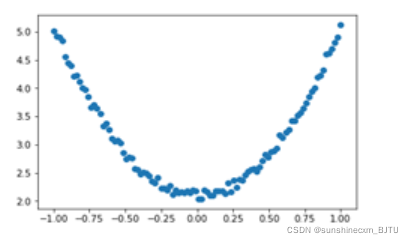当前位置:网站首页>PyTorch 14. module类
PyTorch 14. module类
2022-04-23 06:11:00 【DCGJ666】
PyTorch 14. module类
module类
pytorch中其实一般没有特别明显的Layer和Module的区别,不管是自定义层、自定义块、自定义模型,都是通过继承Module类完成的,其实Sequential类也是继承Module类。
module类的定义:
class Module(object):
def __init__(self):
def forward(self, *input):
def add_module(self,name,module):
def cuda(self,device=None):
def cpu(self):
def __call__(self, *input, **kwargs):
def parameters(self, recurse=True):
def named_parameters(self, prefix='', recurse=True):
def children(self):
def named_children(self):
def modules(self):
def named_modules(self,memo=None,prefix=''):
def train(self,mode=True):
def eval(self):
def zero_grad(self):
def __repr__(self):
def __dir__(self):
我们在定义自己的网络的时候,需要继承nn.Module类,并重新实现构造函数__init__构造函数和forward这两个方法。
注意技巧:
(1)一般把网络中具有可学习参数的层(如全连接层,卷积层等)放在构造函数__init__()中,当然我也可以把不具有参数的层也放在里面
(2)一般把不具有可学习参数的层(如ReLU, dropout, BatchNormalnation层)可放在构造函数中,也可不放在构造函数中,如果不放在构造函数__init__里面,则在forward方法里面可以使用nn.functional来代替
(3)forward方法是必须要重写的,它是实现模型的功能,实现各个层之间的连接关系的核心
注意:只要在module中__init__定义的层,即使forward中没有使用到,模型保存时,也会保存该网络层,因此如果不需要的东西就不要放到__init__
torch.nn.Module类的多种实现
方法1:通过Sequential层来包装层,即将几个层包装在一起作为一个大的层
import torch.nn as nn
from collections import OrderedDict
class MyNet(nn.Module):
def __init__(self):
super(MyNet, self).__init__()
self.conv_block = nn.Sequential(
nn.Conv2d(3, 32, 3,1,1),
nn.ReLU(),
nn.MaxPool2d(2)
)
self.dense_block = nn.Sequential(
nn.Linear(32*3*3, 128),
nn.ReLU(),
nn.Linear(128,10)
)
def forward(self,x):
conv_out = self.conv_block(x)
res = conv_out.view(conv_out.size(0),-1)
out = self.dense_block(res)
return out
model = MyNet()
print(model)
这里在每一个包装块里面,各个层是没有名称的,默认按照0,1,2,3,4排序。
方法2
import torch.nn as nn
from collections import OrderedDict
class MyNet(nn.Module):
def __init__(self):
super(MyNet, self).__init__()
self.conv_block = nn.Sequential(
OrderedDict(
[
("conv1", nn.Conv2d(3, 32, 3, 1, 1)),
("relu1", nn.ReLU()),
("pool", nn.MaxPool2d(2))
]
))
self.dense_block = nn.Sequential(
OrderedDict([
("dense1", nn.Linear(32 * 3 * 3, 128)),
("relu2", nn.ReLU()),
("dense2", nn.Linear(128, 10))
])
)
def forward(self, x):
conv_out = self.conv_block(x)
res = conv_out.view(conv_out.size(0), -1)
out = self.dense_block(res)
return out
model = MyNet()
print(model)
方法3
import torch.nn as nn
from collections import OrderedDict
class MyNet(nn.Module):
def __init__(self):
super(MyNet, self).__init__()
self.conv_block=torch.nn.Sequential()
self.conv_block.add_module("conv1",torch.nn.Conv2d(3, 32, 3, 1, 1))
self.conv_block.add_module("relu1",torch.nn.ReLU())
self.conv_block.add_module("pool1",torch.nn.MaxPool2d(2))
self.dense_block = torch.nn.Sequential()
self.dense_block.add_module("dense1",torch.nn.Linear(32 * 3 * 3, 128))
self.dense_block.add_module("relu2",torch.nn.ReLU())
self.dense_block.add_module("dense2",torch.nn.Linear(128, 10))
def forward(self, x):
conv_out = self.conv_block(x)
res = conv_out.view(conv_out.size(0), -1)
out = self.dense_block(res)
return out
model = MyNet()
print(model)
上面的方法2和方法3,在每一个包装块中,每个层都是有名称的。
特别注意:Sequential类虽然继承自Module类,二者有相似部分,但是也有很多不同的部分,集中体现在:
Sequential类实现了整数索引,故而可以使用model[index]这样的方式获取一个层,但是Module类并没有实现整数索引,不能够通过整数索引来获得层,但是它提供了几个主要方法,如下:
具体内容可以查看我的这一篇博客
children和modules之间的差异性
注意pytorch里面不管是模型、层、激活函数、损失函数都可以当成是Module的拓展,所以modules和named_modules会层层迭代,由浅入深,将每个自定义块block、然后block里面的每个层都当成是module来迭代,而children就比较直观,就表示所谓的“孩子”,所以没有层层深入
版权声明
本文为[DCGJ666]所创,转载请带上原文链接,感谢
https://blog.csdn.net/DCGJ666/article/details/121714323
边栏推荐
- Computer shutdown program
- 红外传感器控制开关
- Android interview Online Economic encyclopedia [constantly updating...]
- Paddleocr image text extraction
- 画 ArcFace 中的 margin 曲线
- GEE配置本地开发环境
- MySQL notes 4_ Primary key auto_increment
- Pytorch模型保存与加载(示例)
- 【3D形状重建系列】Implicit Functions in Feature Space for 3D Shape Reconstruction and Completion
- 【动态规划】不同路径2
猜你喜欢

What did you do during the internship
![[point cloud series] pnp-3d: a plug and play for 3D point clouds](/img/83/3662bc668602110236e43ee0b9d7ac.png)
[point cloud series] pnp-3d: a plug and play for 3D point clouds

第3章 Pytorch神经网络工具箱

【点云系列】点云隐式表达相关论文概要

Chapter 2 pytoch foundation 2

Fill the network gap

Bottom navigation bar based on bottomnavigationview

Infrared sensor control switch

机器学习——PCA与LDA

Chapter 5 fundamentals of machine learning
随机推荐
cmder中文乱码问题
【2021年新书推荐】Artificial Intelligence for IoT Cookbook
1.2 preliminary pytorch neural network
Cancel remote dependency and use local dependency
机器学习——模型优化
Keras如何保存、加载Keras模型
[dynamic programming] different paths 2
三子棋小游戏
免费使用OriginPro学习版
【Tensorflow】共享机制
[2021 book recommendation] kubernetes in production best practices
Component based learning (1) idea and Implementation
机器学习 三: 基于逻辑回归的分类预测
【点云系列】Multi-view Neural Human Rendering (NHR)
第8章 生成式深度学习
.net加载字体时遇到 Failed to decode downloaded font:
【点云系列】 场景识别类导读
[Point Cloud Series] SG - Gan: Adversarial Self - attachment GCN for Point Cloud Topological parts Generation
GEE配置本地开发环境
第5 章 机器学习基础